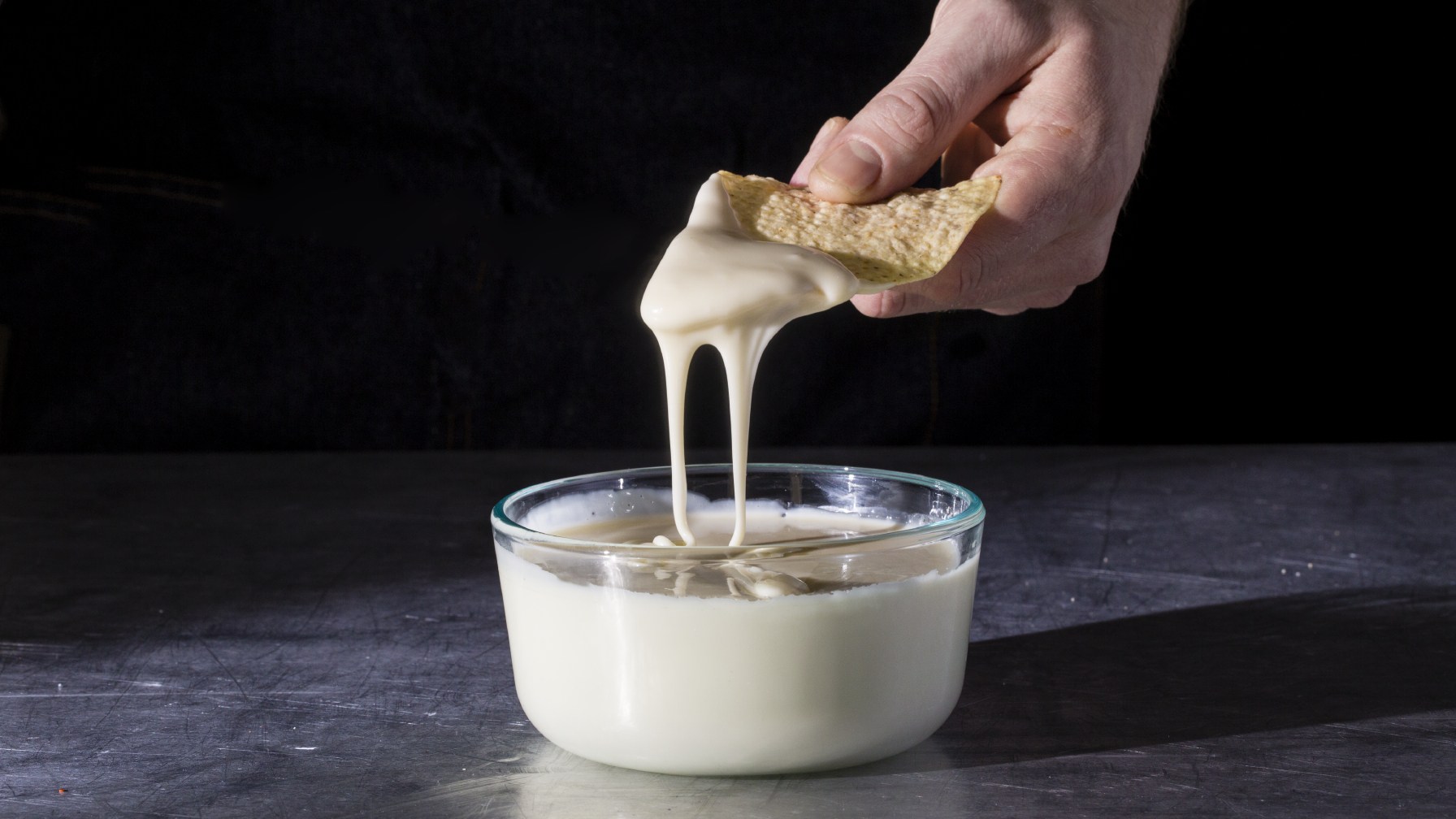In this weekly series, Associate Editor Tim Chin and Test Cook Sasha Marx take you behind the scenes of Cook’s Science and give you a glimpse into our recipe development process, from how we come up with recipe ideas, to test kitchen failures, to discoveries we make along the way. This week, we hear from Sasha about the trials and tribulations of creating a better cheese dip.
Can perfect gooey, melty, stretchy cheese also be delicious? That’s the question I’ve been working on in the test kitchen for the past couple of weeks. While I see the argument that all cheese is inherently tasty, there are levels of flavor that separate a young Monterey Jack from Parmigiano Reggiano or an aged cheddar. The difference, of course, comes down to age. During aging, a host of microorganisms turn bland curds into the intensely-flavored cheeses we love. But there are also major changes in texture during this time. As cheese ages, its casein protein network becomes stronger, making the cheese more prone to breaking when heated, as fat trapped in the protein network melts well before the proteins loosen and begin to flow. Simply put: young cheese melts well but doesn’t pack as much of a flavor punch as more mature cheeses (which don’t melt so well).
With the Super Bowl just around the corner (Go Pats!), we felt it was our duty to address the problem of flavorless nacho cheese (traditionally made with Colby, Swiss, and young cheddar cheeses) and develop a recipe for a cheese sauce worthy of a spot at the game day buffet table. To pull this off, we turned to an ingredient our Executive Editors Dan and Molly had talked up on their recent Burger Tour: sodium citrate. Sodium citrate is a “melting salt” used in the making of processed cheeses like Velveeta and American cheese. It strengthens the emulsion of cheese and, as indicated by its categorization, boosts melting properties. (Stay tuned for an upcoming article from our Senior Editor Paul Adams that explores this ingredient in all its scientific glory.) Employing sodium citrate in a cheese sauce also allows you to use older (read: more flavorful) cheeses. Nacho cheese that actually tastes like cheese!
Armed with a bag of sodium citrate, a handful of Lactaids, and over fifteen pounds of cheese, I got to work. The first order of business was to find a cheese blend that upped the ante on flavor but didn’t depart completely from the essence of nacho cheese. I tested dozens of combinations using various cheeses at different ratios. For flavor, we all agreed that our favorite permutation was an aged cheddar and Gruyère blend that had a great balance of tang and nuttiness. However, even with the addition of sodium citrate, the sauce wasn’t completely smooth in the way that other blends that included younger Swiss cheese were. What?? I thought that sodium citrate was the miracle solution to all my cheese-melting problems. Apparently not. When I tweaked the ratios of the cheddar-Gruyère blend to make room for a tiny amount of Swiss (just over 6%), we achieved the perfect nacho cheese texture—gooey, melty, stretchy—without sacrificing the awesome flavor of the more mature cheeses.
Once we were satisfied with our aged cheese sauce, I set my sights on another classic nacho component that I felt could use some help: the beef. The ground beef sprinkled over top of heaping sports bar nachos is usually pretty sad, dry, and flavorless. It’s hard to blame the kitchen though—it would be a logistical nightmare to cook beef to order for every plate of nachos. But what if you could flip the script and get all the delicious seared beef flavor we love into the cheese sauce itself? Enter: Beef fat nacho cheese. I tried a number of different beef fat delivery systems (technical jargon helps me feel better about what I subject my body to during recipe testing)—roasted marrow, melted tallow, and suet. All three were rich, but one-dimensional in flavor. I decided to go with high-fat ground beef, the nacho staple, instead. I seared the meat, but instead of taking it off the heat once it was just cooked through, I kept it going on the stovetop to render out all of the fat, which the beef then began to fry in (think: traditional Mexican carnitas). Once it had turned a deep, golden brown, I strained out the meat and whisked the fat into the cheese sauce. It tasted like the liquid essence of cheeseburger. We love it on chips but why stop there? Put it on fries, macaroni, or even a burger for an Inception-style meta-burger.

We also had a couple of epic failure cheese sauce moments. One of the more entertaining ones involved an attempt to make a blue cheese sauce for a twist on “buffalo wing nachos”. First of all, puréed blue cheese is a pretty unappetizing blue-grey color (think, elementary school paste). We achieved intense blue cheese flavor, but in an early tasting Dan raised a valid question: “Are we creating something that nobody wants?” There’s a reason blue cheese gets diluted with sour cream in sauce and dressings—it’s intense. I then tried to solve the color issue by incorporating hot sauce in the blue cheese emulsion, which proved to be a huge mistake. Our perfectly smooth sauce instantly curdled into a disgusting hot mess and let’s just say the color did not improve. Cheese sauces, like most dairy emulsions, are very pH-sensitive, and adding an acidic ingredient like Frank’s RedHot can throw off the entire balance. You can regulate that pH with other “melting salts” like sodium hexametaphosphate, but we all agreed that the buffalo-blue cheese nacho sauce was not something we cared to revisit. Don’t worry though, we won’t be able to forget about it any time soon.
Got ideas about more foods in need of cheese sauce love? Nacho disasters? Cheese puns (I think I’ve finally exhausted my supply)? Let us know in the comments. And be sure to keep an eye out for our upcoming contributions to the nacho cheese canon . . . just in time for Super Bowl Sunday.
Test Kitchen Photography by Kevin White.
Styled Food Photography by Steve Klise.



